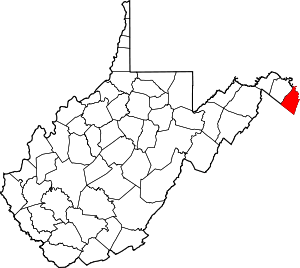Harpers Ferry, West Virginia
Harpers Ferry, population 286 at the 2010 census, is a historic town in Jefferson County, West Virginia, United States, in the lower Shenandoah Valley. It is situated at the confluence of the Potomac and Shenandoah rivers, where the U.S. states of Maryland, Virginia, and West Virginia meet. It is the easternmost town in West Virginia and during the Civil War was the northernmost point of Confederate-controlled territory.
Harpers Ferry, West Virginia | |
|---|---|
Town | |
| Corporation of Harpers Ferry | |
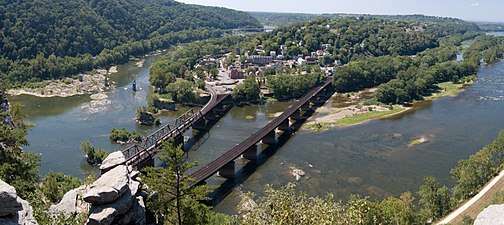 Panoramic view of Harpers Ferry from Maryland Heights, with the Shenandoah (left) and Potomac (right) rivers. | |
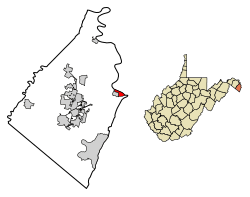 Location of Harpers Ferry in Jefferson County, West Virginia. | |
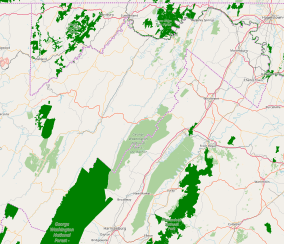 Harpers Ferry, West Virginia Location of Harpers Ferry in Jefferson County, West Virginia.  Harpers Ferry, West Virginia Harpers Ferry, West Virginia (West Virginia)  Harpers Ferry, West Virginia Harpers Ferry, West Virginia (the United States) | |
| Coordinates: 39°19′27″N 77°44′2″W | |
| Country | United States |
| State | West Virginia |
| County | Jefferson |
| Government | |
| • Mayor | Wayne Bishop |
| • Recorder | Kevin Carden |
| Area | |
| • Total | 0.62 sq mi (1.62 km2) |
| • Land | 0.54 sq mi (1.39 km2) |
| • Water | 0.09 sq mi (0.23 km2) |
| Elevation | 489 ft (149 m) |
| Population | |
| • Total | 286 |
| • Estimate (2019)[3] | 282 |
| • Density | 527.10/sq mi (203.45/km2) |
| Time zone | UTC-5 (Eastern (EST)) |
| • Summer (DST) | UTC-4 (EDT) |
| ZIP code | 25425 |
| Area code(s) | 304 |
| FIPS code | 54-35284[4] |
| GNIS feature ID | 1560593[5] |
The town's original, lower section is on a flood plain created by the two rivers and surrounded by higher ground and is within Harpers Ferry National Historical Park. Most of the remainder, which includes the more highly populated area, is included in the separate Harpers Ferry Historic District. Two other National Register of Historic Places properties adjoin the town: the B & O Railroad Potomac River Crossing and St. Peter's Roman Catholic Church.
The town was formerly spelled Harper's Ferry with an apostrophe—in the 18th century, it was the ferry owned and operated by Robert Harper—and that form continues to appear in some references.[6]
Strategic importance
Because of its geography, Harpers Ferry was a vitally important junction point. In colonial times and through the early U.S. years, its location at the junction of two rivers, and the feasibility of a ferry – the first regular ferry across the Potomac, antedating the founding of Washington – made it a natural site of commerce. Harpers Ferry has a commanding central location on the Chesapeake and Ohio Canal, running alongside the Potomac and avoiding its rapids, linking Washington with points west.
The word "ferry" in the town's name – the ferry ended in 1824, when a covered wooden road bridge was built – conceals the fact that Harpers Ferry is the site of the first and for many years the only railroad bridge across the Potomac River, the Baltimore & Ohio Railroad's bridge, built in 1836–37. It is also the site of the first railroad intersection in the United States, where the older Baltimore & Ohio was met by the newer Winchester and Potomac Railroad. At the time the Civil War began, it was the only railroad link between the Northern and Southern states. Thus, it was a natural conduit for Union incursions into the South. One of Stonewall Jackson's first actions for the Confederacy was the Great Train Raid of 1861, in which he disabled the Baltimore and Ohio Railroad for almost a year by destroying infrastructure and stealing rolling stock.
It also commanded the railroad and canal routes connecting Washington with points west and the Ohio Valley. Vital telegraph lines connecting Washington with points west also went through Harpers Ferry.
Historically, Harpers Ferry is best known for John Brown's raid in 1859, in which he attempted to use the town and the weapons in its Federal Armory (munitions plant) as the base for a slave revolt, planned to expand south into Virginia.[7] At that time and until 1863, it was part of Virginia.
In the 20th and 21st centuries, the Appalachian Trail Conservancy (ATC) headquarters is in Harpers Ferry. The Appalachian Trail passes directly through town, which some consider the psychological midpoint of the trail,[8][9] although the exact physical midpoint is farther north, in Pennsylvania. Uniquely, the towns of Harpers Ferry and Bolivar partnered with the ATC to be declared a united Appalachian Trail Community.[10] Other popular outdoor activities include white water rafting, fishing, mountain biking, tubing, canoeing, hiking, zip lining, and rock climbing.
History
Earlier years
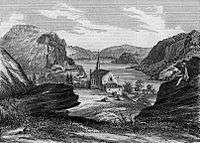
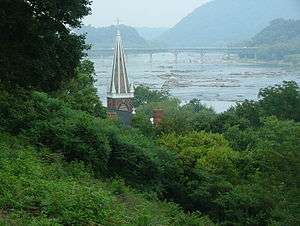
In 1733, Peter Stephens, a squatter, had settled on land near "The Point" (the area where the Potomac and Shenandoah Rivers meet), and established a ferry from Virginia (now West Virginia) to Maryland, across the Potomac. Fourteen years later (1747), while traveling from Maryland to Virginia, Robert Harper passed through the area which was named "The Hole" (the gap in the mountains along the Potomac River). Harper recognized the potential for industry, given the power the two rivers could generate, and the traffic he could ferry across the Potomac River. Harper paid Stephens 30 guineas for what was essentially Stephens' squatting rights, since the land actually belonged to Lord Fairfax.[11]:12
In April 1751, Harper purchased 126 acres of land from Lord Fairfax. In 1761, the Virginia General Assembly granted Harper the right to establish and maintain a ferry across the Potomac River (even though a ferry had been functioning successfully in the area before and after Harper first settled there). In 1763, the Virginia General Assembly established the town of "Shenandoah Falls at Mr. Harpers Ferry."[12]:100
On October 25, 1783, Thomas Jefferson visited Harpers Ferry. He viewed "the passage of the Potomac through the Blue Ridge" from a rock that is now named for him. This stop took place as Jefferson was traveling to Philadelphia and passed through Harpers Ferry with his daughter Patsy. Jefferson called the site "perhaps one of the most stupendous scenes in nature,"[13]:22 and stated that, "This scene is worth a voyage across the Atlantic."[14]
George Washington, as president of the Patowmack Company (which was formed to complete river improvements on the Potomac and its tributaries), traveled to Harpers Ferry during the summer of 1785 to determine the need for bypass canals. In 1794, Washington's familiarity with the area led him to propose the site for a new United States armory and arsenal. Some of Washington's family moved to the area; his great-great-nephew, Colonel Lewis Washington, was held hostage during John Brown's raid in 1859, and George's brother Charles Washington founded the nearby Jefferson County town of Charles Town.[15]:13
In 1796, the federal government purchased a 125-acre (0.5 km2) parcel of land from the heirs of Robert Harper. Construction began on the United States Armory and Arsenal at Harpers Ferry in 1799.[16] This was one of only two such facilities in the U.S., the other being Springfield, Massachusetts. Together they produced most of the small arms for the U.S. Army. The town was transformed into an industrial center; between 1801 and 1861, when it was destroyed to prevent capture during the Civil War, the armory produced more than 600,000 muskets, rifles and pistols. Inventor Captain John H. Hall pioneered the use of interchangeable parts in firearms manufactured at his rifle works at the armory between 1820 and 1840; his M1819 Hall rifle was the first breech-loading weapon adopted by the U.S. Army.[17]:151
Industrialization continued in 1833 when the Chesapeake & Ohio Canal reached Harpers Ferry, linking it with Washington, D.C. A year later, the Baltimore & Ohio Railroad began service through the town.[18]
John Brown's raid
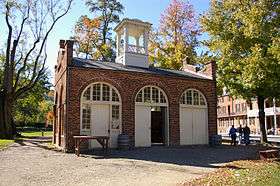
On October 16, 1859, the abolitionist John Brown led a group of 21 men in a raid on the arsenal. Five of the men were black: three free black men, one freed slave, and one fugitive slave. During this time assisting fugitive slaves was illegal under the Fugitive Slave Act of 1850. Brown attacked and captured several buildings; hoping to secure the weapons depot and arm the slaves, starting a revolt across the South. Brown also brought 1,000 steel pikes, which were forged in Connecticut by a blacksmith and abolitionists sympathizer, Charles Blair; however, the pikes would see no action as Brown failed to rally the slaves to revolt.[19] The first shot of the raid mortally wounded Heyward Shepherd,[20] a free black man who had been a baggage porter for the B&O Railroad. The noise from that shot alerted Dr. John Starry shortly after 1:00 am. He walked from his nearby home to investigate the shooting and was confronted by Brown's men. Starry stated that he was a doctor but could do nothing more for Shepherd, and Brown's men allowed him to leave. Instead of going home, Starry went to the livery and rode to neighboring towns and villages, alerting residents to the raid. When Starry reached nearby Charles Town, the church bells were rung to arouse the citizens from their sleep. John Brown's men were quickly pinned down by local citizens and militia, and forced to take refuge in the engine house adjacent to the armory.[21]
The Secretary of War asked the Navy Department for a unit of United States Marines, the nearest troops.[22] Lieutenant Israel Greene was ordered to take a force of 86 Marines to the town. In need of an officer to lead the expedition, U.S. Army Lieutenant Colonel Robert E. Lee was found on leave nearby and was assigned as commander along with Lt. J. E. B. Stuart as his aide-de-camp. Lee led the unit in his regular civilian clothes, as none of his uniforms were available when he accepted the command. The whole contingent arrived by train on October 18, and after negotiation failed they stormed the fire house and captured most of the raiders, killing a few and suffering a single casualty themselves. Brown was tried for treason against the Commonwealth of Virginia, convicted and hanged in nearby Charles Town. Starry's testimony was integral to his conviction. Following the prosecution (by Andrew Hunter), "John Brown captured the attention of the nation like no other abolitionist or slave owner before or since." The Marines returned to their barracks and Col. Lee returned to finish his leave.[23]
Civil War
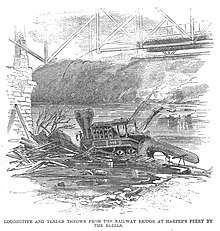
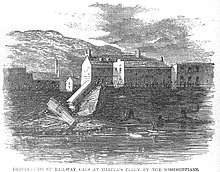
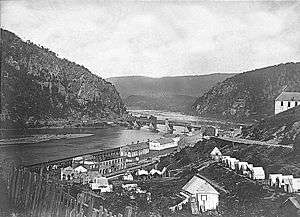
The Civil War was disastrous for Harpers Ferry, which changed hands eight times between 1861 and 1865.[24] Because of the town's strategic location on the railroad and at the northern end of the Shenandoah Valley, both Union and Confederate troops moved through Harpers Ferry frequently. The town's garrison of 14,000 Federal troops played a key role in the Confederate invasion of Maryland in September 1862. Gen. Robert E. Lee did not want to continue on to Maryland without capturing the town. It was on his supply line and could control one of his possible routes of retreat if the invasion did not go well.[25]
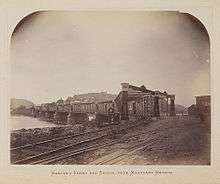
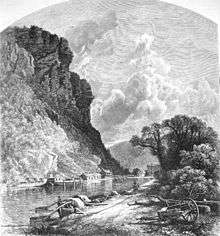
Dividing his army of approximately 40,000 into four sections, Lee used the cover of the mountains to send three columns under Stonewall Jackson to surround and capture the town.[26] The Battle of Harpers Ferry started with light fighting September 13 as the Confederates tried to capture the Maryland Heights to the northeast, while John Walker moved back over the Potomac to capture Loudoun Heights south of town. After a Confederate artillery bombardment on September 14 and 15, the Federal garrison surrendered. With 12,419 Federal troops captured by Jackson, the surrender at Harpers Ferry was the largest surrender of U.S. military personnel until the Battle of Bataan in World War II.[25]
Because of the delay in capturing Harpers Ferry and the movement of Federal forces to the west, Lee was forced to regroup at the town of Sharpsburg. Two days later he commanded troops in the Battle of Antietam, which had the highest number of deaths among troops of any single day in United States military history. By July 1864, the Union again had control of Harpers Ferry. On 4 July 1864, the Union commanding Gen. Franz Sigel withdrew his troops to Maryland Heights. From there he resisted Jubal Anderson Early's attempt to enter the town and drive the Federal garrison from Maryland Heights.[27]
20th century
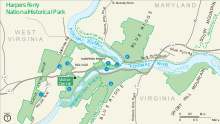
On August 15, 1906, author and scholar W. E. B. Du Bois led the first meeting on American soil of the newly founded Niagara Movement. The conference was held at the campus of Storer College, a historically black college that operated until 1955. (The campus became part of Harpers Ferry National Historical Park.) The three-day gathering, which was held to work for civil rights for African Americans, was later described by DuBois as "one of the greatest meetings that American Negroes ever held." Attendees of the 1906 meeting walked from Storer College to the nearby farm of the Murphy family. It was the site of the historic fort and armory where John Brown's quest to free four million enslaved African Americans reached its climax.[29]
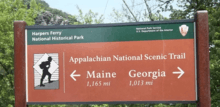
The population of Harpers Ferry declined significantly in the 20th century. In 1944 Congress authorized the establishment of Harpers Ferry National Historical Park, to take in most of the town and have it administered by the National Park Service. The majority of the existing homes in Harpers Ferry are historic. Some are registered in the National Register of Historic Places.
21st century
On July 23, 2015, a fire broke out in downtown Harpers Ferry, destroying eight or nine businesses and two apartments in two historic buildings. The buildings are being rebuilt.[30][31]
In the early morning of December 21, 2019, multiple cars of a train owned by CSX derailed from the railroad bridge crossing the Potomac River. The derailment damaged a portion of the Goodloe E. Byron Memorial Pedestrian Walkway, which is attached to the railroad bridge and connects the Appalachian Trail between West Virginia and Maryland. The accident did not result in any injuries or fatalities but effectively inhibited all pedestrian access across the Potomac River.[32] The bridge reopened in early July 2020.[33]
Transportation
Roads and highways
_at_U.S._Route_340_Alternate_(Shenandoah_Street)_in_Harpers_Ferry%2C_Jefferson_County%2C_West_Virginia.jpg)
The only significant highway providing access to Harpers Ferry is U.S. Route 340. Although signed north-south, the road runs generally eastward from Harpers Ferry across the northern tip of Loudoun County, Virginia after crossing the Shenandoah River, then quickly crosses the Potomac River into Maryland, eventually reaching its terminus at Frederick. To the west, U.S. Route 340 passes through Charles Town before turning southwest and traversing the eastern edge of Virginia's Shenandoah Valley. Harpers Ferry and neighboring Bolivar host an unsigned alternate route of U.S. Route 340, which follows Washington Street, High Street and Shenandoah Street.
Rail
_train.jpg)
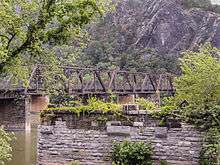
Amtrak provides service to Harpers Ferry two times a day (once in each direction) on the Capitol Limited. It is also served by MARC on the Brunswick Line. The city's passenger rail station is at the West Virginia end of the historic railroad bridge across the Potomac River. In addition about 40–50 CSX freight trains daily pass through Harpers Ferry and over the bridge spanning the Potomac River.
Geography
According to the United States Census Bureau, the town has a total area of 0.61 square miles (1.58 km2), of which, 0.53 square miles (1.37 km2) is land and 0.08 square miles (0.21 km2) is water.[35] Some properties are currently threatened by development.[36]
From most of Harpers Ferry, a fading advertisement for Mennen's Borated Talcum Toilet Powder painted on the cliff face of Maryland Heights decades ago is still visible.[37]
Climate
The climate in this area is characterized by hot, humid summers and generally mild to cool winters, with yearly snowfall averaging 20.7 inches. According to the Köppen Climate Classification system, Harpers Ferry has a humid subtropical climate, abbreviated "Cfa" on climate maps.[38]
Demographics
| Historical population | |||
|---|---|---|---|
| Census | Pop. | %± | |
| 1850 | 1,747 | — | |
| 1860 | 1,339 | −23.4% | |
| 1880 | 764 | — | |
| 1890 | 958 | 25.4% | |
| 1900 | 896 | −6.5% | |
| 1910 | 766 | −14.5% | |
| 1920 | 713 | −6.9% | |
| 1930 | 705 | −1.1% | |
| 1940 | 665 | −5.7% | |
| 1950 | 822 | 23.6% | |
| 1960 | 572 | −30.4% | |
| 1970 | 423 | −26.0% | |
| 1980 | 361 | −14.7% | |
| 1990 | 308 | −14.7% | |
| 2000 | 307 | −0.3% | |
| 2010 | 286 | −6.8% | |
| Est. 2019 | 282 | [3] | −1.4% |
| U.S. Decennial Census[39] | |||
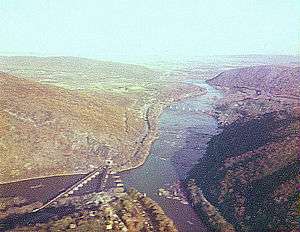
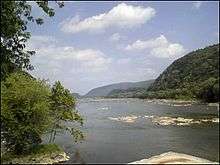
2010 census
As of the census[2] of 2010, there were 286 people, 131 households, and 78 families residing in the town. The population density was 539.6 inhabitants per square mile (208.3/km2). There were 175 housing units at an average density of 330.2 per square mile (127.5/km2). The racial makeup of the town was 94% White, 4% African American, 1% Native American, 0% from other races, and 1% from two or more races. Hispanic or Latino of any race were 1% of the population.
There were 131 households of which 21% had children under the age of 18 living with them, 44% were married couples living together, 13% had a female householder with no husband present, 3% had a male householder with no wife present, and 41% were non-families. 29% of all households were made up of individuals and 15% had someone living alone who was 65 years of age or older. The average household size was 2.18 and the average family size was 2.69.
The median age in the town was 52 years. 17% of residents were under the age of 18; 3% were between the ages of 18 and 24; 19% were from 25 to 44; 38% were from 45 to 64; and 23% were 65 years of age or older. The gender makeup of the town was 49.3% male and 50.7% female.
2000 census
In the census of 2000, there were 307 people, 153 households and 89 families residing in the town. The median income for a household in the town was $52,344, and the median income for a family was $70,313.
Politics
Federally, Harpers Ferry is part of West Virginia's 2nd congressional district and is represented by Alex Mooney (R) in the United States House of Representatives. Mooney was first elected in 2014.
Notable people
- John Anthony Copeland, Jr.[40]
- Shields Green[41]
- Drusilla Dunjee Houston[42]
- John Henry Kagi[43]
- Lewis Sheridan Leary[44]
- Walton Danforth Stowell[45]
See also
References
- "2019 U.S. Gazetteer Files". United States Census Bureau. Retrieved August 7, 2020.
- "U.S. Census website". United States Census Bureau. Retrieved January 24, 2013.
- "Population and Housing Unit Estimates". United States Census Bureau. May 24, 2020. Retrieved May 27, 2020.
- "U.S. Census website". United States Census Bureau. Retrieved January 31, 2008.
- "US Board on Geographic Names". United States Geological Survey. October 25, 2007. Archived from the original on February 12, 2012. Retrieved January 31, 2008.
- For example, Horace Greeley, The American Conflict: A History of the Great Rebellion in the United States of America, 1860–64. Volume: 1. (1866), p. 279; French Ensor Chadwick, Causes of the Civil War, 1859–1861 (1906) p. 74; Allan Nevins, The Emergence of Lincoln (1950) v, 2 ch 3; James M. McPherson, Battle Cry of Freedom: The Civil War Era (1988), p. 201; Stephen W. Sears, Landscape Turned Red: The Battle of Antietam (2003) p. 116.
- "Harpers Ferry Town Website". Archived from the original on July 16, 2007. Retrieved July 19, 2007.
- "Hikes - Harpers Ferry National Historical Park". U.S. National Park Service. Archived from the original on October 4, 2017. Retrieved 28 April 2018.
- "Headquarters and psychological mid-point of the Appalachian Trail, Harpers Ferry, West Virginia". Library of Congress. Archived from the original on September 21, 2017. Retrieved April 28, 2018.
- "Harper's Ferry & Bolivar, West Virginia: An Appalachian Trail Community". Appalachian Trail Conservancy. Retrieved May 24, 2018.
- Bushong, M. K. (2009). A History of Jefferson County, West Virginia [1719-1940]. Heritage Books.
- O’Dell, C. (1995). Pioneers of Old Frederick County, Virginia. Walsworth Publishing Company.
- Beckman, J. A. (2006). Harpers Ferry. Arcadia Publishing.
- "Jefferson Rock". National Park Service. 2019-10-30.
- Gale, K. (2006). Lewis and Clark Road Trips: Exploring the Trail Across America. River Junction Press LLC.
- "Archived copy". Archived from the original on 2008-11-08. Retrieved 2008-11-12.CS1 maint: archived copy as title (link); Harpers Ferry NHP Armory and Arsenal; Retrieved on 2007-04-05
- Congressional Serial Set. (1868). U.S. Government Printing Office.
- Hahn, T. F. (n.d.). Towpath Guide to the Chesapeake & Ohio Canal: Harpers Ferry to Fort Frederick. American Canal and Transportation Center.
- "John Brown Pike - Kansapedia - Kansas Historical Society". www.kshs.org.
- "An "Ever Present Bone of Contention": The Heyward Shepherd Memorial". Archived from the original on 2008-05-26. Retrieved 2008-02-24.; An "Ever Present Bone of Contention": The Heyward Shepherd Memorial; Retrieved on 2008-02-24
- Horton, James Oliver; Lois E. Horton (2006). Slavery and the Making of America. Oxford University Press USA. p. 162. ISBN 978-0195304510.
- Sullivan, David (1997). The United States Marine Corps in the Civil War – The First Year. White Mane Publishing Company, Inc. pp. 1–27. ISBN 978-1-57249-040-6.
- Col. Robert E. Lee, Report to the Adjutant General Concerning the Attack at Harper's Ferry Archived 2010-07-22 at the Wayback Machine, University of Missouri Kansas City, Law School
- Reynolds, John. John Brown: Abolitionist. New York: Knopf, 2005 p. 309
- Tucker, S. C. (2013). American Civil War: The Definitive Encyclopedia and Document Collection [6 volumes]: The Definitive Encyclopedia and Document Collection. ABC-CLIO.
- "Harpers Ferry NHP Stonewall Jackson Woodward engraving published in the Aldine Magazine, Vol. VI, No. 7 (July 1873) p. 134". Archived from the original on 2006-06-20.
- Chisholm, Hugh, ed. (1911). . Encyclopædia Britannica (11th ed.). Cambridge University Press.
- "Archived copy" (PDF). Archived (PDF) from the original on September 27, 2007. Retrieved July 20, 2007.CS1 maint: archived copy as title (link)
- Gilbert, David T. (August 11, 2006). "The Niagara Movement at Harpers Ferry". National Park Service. Archived from the original on October 27, 2007. Retrieved October 9, 2007.
- Hedgpeth, Dana; Woodrow Cox, John (July 23, 2015). "Fire destroys businesses in historic area of Harpers Ferry". The Washington Post. Archived from the original on 25 July 2015. Retrieved 25 July 2015.
- Toni Milbourne, Shepherdstown Chronicle Editor (July 31, 2015). "Shepherdstown Chronicle, 7/31/2015, Harpers Ferry blaze destroys buildings, businesses, homes". Shepherdstown Chronicle. Retrieved August 7, 2015.
- "Information about train derailment and footbridge at Harpers Ferry". NPS.gov. May 20, 2020. Retrieved 29 June 2020.
- WV Metro News: "Footbridge at Harpers Feery Reopens" 3 July 2020
- "US Gazetteer files: 2010, 2000, and 1990". United States Census Bureau. 2011-02-12. Retrieved 2011-04-23.
- "US Gazetteer files 2010". United States Census Bureau. Archived from the original on 2011-02-20. Retrieved 2013-01-24.
- "Development Threatens Park Experience - Harpers Ferry National Historical Park (U.S. National Park Service)". Archived from the original on 4 November 2012. Retrieved 15 September 2016.
- Harpers Ferry Vignette, John Armstrong, page 5 of The Classic Layout Designs of John Armstrong: A Compilation, Kalmbach Publishing Company, 2001, ISBN 0-89024-417-0
- "Harpers Ferry, West Virginia Köppen Climate Classification (Weatherbase)". Archived from the original on October 21, 2016. Retrieved 15 September 2016.
- "Census of Population and Housing". Census.gov. Retrieved June 4, 2015.
- Steven Lubet, The "Colored Hero" of Harper's Ferry: John Anthony Copeland and the War Against Slavery (Cambridge University Press, 2015) p.181.
- Hinton, Richard J. (1894). John Brown and His Men. Funk and Wagnalls. pp. 507–5088.
- "Houston, Drusilla Dunjee (1876–1941)". Oklahoma History Center. Archived from the original on 4 February 2017. Retrieved 4 February 2017.
- Karen Whitman, "Re-evaluating John Brown's Raid at Harpers Ferry" Archived 2007-09-29 at the Wayback Machine, West Virginia Culture, accessed April 12, 2007
- "The Conspirators Biographies". William Elsey Connelley, John Brown (Topeka: Crane & Company, 1900), 340-347; and Oswald Garrison Villard, John Brown 1800-1859: A Biography Fifty Years After (1910, reprint, Gloucester, MA: Peter Smith, 1965), 678-687. 2008. Archived from the original on 2009-07-09. Retrieved 2010-05-24.
- Harpers Ferry Town Council. Harpers Ferry Town Council Membership (1851–2009). (Harpers Ferry: Harpers Ferry Town Council, April 16, 2008).
See also
- Vischer Ferry
- White's Ferry
External links
| Wikimedia Commons has media related to Harpers Ferry, West Virginia. |
| Wikisource has the text of the 1911 Encyclopædia Britannica article Harper's Ferry. |
- Corporation of Harpers Ferry Website
- Harpers Ferry During the Civil War in Encyclopedia Virginia
- Harpers Ferry National Historical Park
- Harpers Ferry Historic Town Foundation


